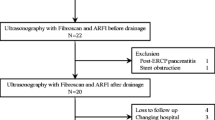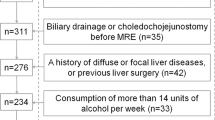Abstract
Background
Transient elastography (with the FibroScan® apparatus) is a recently developed method for evaluating the severity of liver fibrosis by measuring liver elasticity. Liver elasticity may differ from the normal level in patients with obstructive jaundice because the retained bile may expand the liver. Because little is known about liver elasticity in patients with obstructive jaundice, we evaluated this feature in these patients.
Methods
Between April 2007 and April 2008, 178 patients with biliary or pancreatic disease underwent transient elastography at the University of Tokyo Hospital. We excluded 77 patients because of concomitant cirrhotic liver disease, liver tumors, or a history of abdominal surgery. The remaining 101 patients were included in the study and were divided into obstructive jaundice (OJ; n = 43) and nonobstructive jaundice (NJ; n = 58) groups.
Results
The basic patient characteristics did not differ significantly between the two groups, except for the causative diseases. The mean liver elasticity was significantly higher in the OJ group than in the NJ group (12.0 vs. 6.2 kPa, p < 0.01). In 24 patients from the OJ group, transient elastography was performed before and after biliary drainage; there was a marked reduction in the elasticity after the procedure in these patients (p < 0.01).
Conclusions
Liver elasticity increases in patients with biliary obstruction. This increase is reduced after biliary drainage, implying that the increased FibroScan® values before drainage are not due to liver fibrosis, but to temporarily increased elasticity.


Similar content being viewed by others
Abbreviations
- LSM:
-
Liver stiffness measurement
- TE:
-
Transient elastography
References
Bravo AA, Sheth SG, Chopra S. Liver biopsy. N Engl J Med. 2001;344:495–500.
Cadranel JF, Rufat P, Degos F. Practices of liver biopsy in France: results of a prospective nationwide survey. Hepatology. 2000;32:477–81.
Sheela H, Seela S, Caldwell C, Boyer JL, Jain D. Liver biopsy: evolving role in the new millennium. J Clin Gastroenterol. 2005;39:603–10.
Bedossa P, Poynard T. An algorithm for the grading of activity in chronic hepatitis C. Hepatology. 1996;24:289–93.
Maharaj B, Maharaj RJ, Leary WP, Cooppan RM, Naran AD, Pirie D, et al. Sampling variability and the influence on the diagnostic yield of percutaneous needle biopsy of the liver. Lancet. 1986;1:523–5.
Smith EH. Complications of percutaneous abdominal fine-needle biopsy. Radiology. 1991;178:253–8.
Myers RP, Fong A, Shaheen AA. Utilization rates, complications and costs of percutaneous liver biopsy: a population-based study including 4275 biopsies. Liver Int. 2008;28:705–12.
Gilmore IT, Burroughs A, Murray-Lyon IM, Williams R, Jenkins D, Hopkins A. Indications, methods, and outcomes of percutaneous liver biopsy in England and Wales: an audit by the British Society of Gastroenterology and the Royal College of Physicians of London. Gut. 1995;36:437–41.
van der Poorten D, Kwok A, Lam T, Ridley L, Jones DB, Ngu MC, et al. Twenty-year audit of percutaneous liver biopsy in a major Australian teaching hospital. Intern Med J. 2006;36:692–9.
Tateishi R, Yoshida H, Shiina S, Imamura H, Hasegawa K, Teratani T, et al. Proposal of a new prognostic model for hepatocellular carcinoma: an analysis of 403 patients. Gut. 2005;54:419–25.
Ahmed A, Samuels SL, Keeffe EB, Cheung RC. Delayed fatal hemorrhage from pseudoaneurysm of the hepatic artery after percutaneous liver biopsy. Am J Gastroenterol. 2001;96:233–7.
Kowdley KV, Aggarwal AM, Sachs PB. Delayed hemorrhage after percutaneous liver biopsy. Role of therapeutic angiography. J Clin Gastroenterol. 1994;19:50–3.
Sandrin L, Fourquet B, Hasquenoph JM, Yon S, Fournier C, Mal F, et al. Transient elastography: a new noninvasive method for assessment of hepatic fibrosis. Ultrasound Med Biol. 2003;29:1705–13.
Cespedes I, Ophir J, Ponnekanti H, Maklad N. Elastography: Elasticity imaging using ultrasound with application to muscle and breast in vivo. Ultrason Imaging. 1993;15:73–88.
Ophir J, Cespedes I, Ponnekanti H, Yazdi Y, Li X. Elastography: a quantitative method for imaging the elasticity in biological tissues. Ultrason Imaging. 1991;13:111–34.
Parker KJ, Fu D, Graceswki SM, Yeung F, Levinson SF. Vibration sonoelastography and the detectability of lesions. Ultrasound Med Biol. 1998;24:1437–47.
Yeh WC, Li PC, Jeng YM, Hsu HC, Kuo PL, Li ML, et al. Elastic modulus measurements of human liver and correlation with pathology. Ultrasound Med Biol. 2002;28:467–74.
Sandrin L, Tanter M, Gennisson JL, Catheline S, Fink M. Shear elasticity probe for soft tissues with 1D transient elastography. IEEE Trans Ultrason Ferroelectr Freq Control. 2002;49:436–46.
Castera L, Forns X, Alberti A. Non-invasive evaluation of liver fibrosis using transient elastography. J Hepatol. 2008;48:835–47.
Castera L, Vergniol J, Foucher J, Le Bail B, Chanteloup E, Hasser M, et al. Prospective comparison of transient elastography, fibrotest, APRI, and liver biopsy for the assessment of fibrosis in chronic hepatitis C. Gastroenterology. 2005;128:343–50.
Foucher J, Chanteloup E, Vergniol J, Castera L, Le Bsil B, Adhoute X, et al. Diagnosis of cirrhosis by transient elastography (FibroScan): a prospective study. Gut. 2006;55:403–8.
Fraquelli M, Rigamonti C, Casazza G, Conte D, Donato MF, Ronchi G, et al. Reproducibility of transient elastography in the evaluation of liver fibrosis in patients with chronic liver disease. Gut. 2007;56:968–73.
Friedrich-Rust M, Ong MF, Herrmann E, Dries V, Samaras P, Zeuzem S, et al. Real-time elastography for noninvasive assessment of liver fibrosis in chronic viral hepatitis. AJR Am J Roentgenol. 2007;188:758–64.
Friedrich-Rust M, Ong MF, Martens S, Sarrazin C, Bojunga J, Zeuzem S, et al. Performance of transient elastography for the staging of liver fibrosis: a meta-analysis. Gastroenterology. 2008;134:960–74.
Ganne-Carrie N, Ziol M, de Ledinghen V, Douvin C, Marcellin P, Castera L, et al. Accuracy of liver stiffness measurement for the diagnosis of cirrhosis in patients with chronic liver diseases. Hepatology. 2006;44:1511–7.
Ziol M, Handra-Luca A, Kettaneh A, Christidis C, Mal F, Kazemi F, et al. Noninvasive assessment of liver fibrosis by measurement of stiffness in patients with chronic hepatitis C. Hepatology. 2005;41:48–54.
Corpechot C, El Naggar A, Poujol-Robert A, Ziol M, Wendum D, Chazouilleres O, et al. Assessment of biliary fibrosis by transient elastography in patients with PBC and PSC. Hepatology. 2006;43:1118–24.
Roulot D, Czernichow S, Le Clésiau H, Costes JL, Vergnaud AC, Beaugrand M. Liver stiffness values in apparently healthy subjects: influence of gender and metabolic syndrome. J Hepatol. 2008;48:606–13.
Sagir A, Erhardt A, Schmitt M, Haussinger D. Transient elastography is unreliable for detection of cirrhosis in patients with acute liver damage. Hepatology. 2008;47:592–5.
Arena U, Vizzutti F, Corti G, Ambu S, Stasi C, Bresci S, et al. Acute viral hepatitis increases liver stiffness values measured by transient elastography. Hepatology. 2008;47:380–4.
Hammel P, Couvelard A, O’Toole D, Ratouis A, Sauvanat A, Flejou JF, et al. Regression of liver fibrosis after biliary drainage in patients with chronic pancreatitis and stenosis of the common bile duct. N Engl J Med. 2001;344:418–23.
Iida A, Yoshidome H, Shida T, Takano S, Takeuchi D, Kimura F, et al. Does prolonged biliary obstructive jaundice sensitize the liver to endotoxemia? Shock. 2009;31:397–403.
Acknowledgments
The authors thank Dr. Céline Fournier for her kind advice regarding the principle of FibroScan®. This study received no grant support.
Conflict of interest
None of the authors has any conflicts of interest associated with this study.
Author information
Authors and Affiliations
Corresponding author
Rights and permissions
About this article
Cite this article
Yashima, Y., Tsujino, T., Masuzaki, R. et al. Increased liver elasticity in patients with biliary obstruction. J Gastroenterol 46, 86–91 (2011). https://doi.org/10.1007/s00535-010-0290-9
Received:
Accepted:
Published:
Issue Date:
DOI: https://doi.org/10.1007/s00535-010-0290-9




